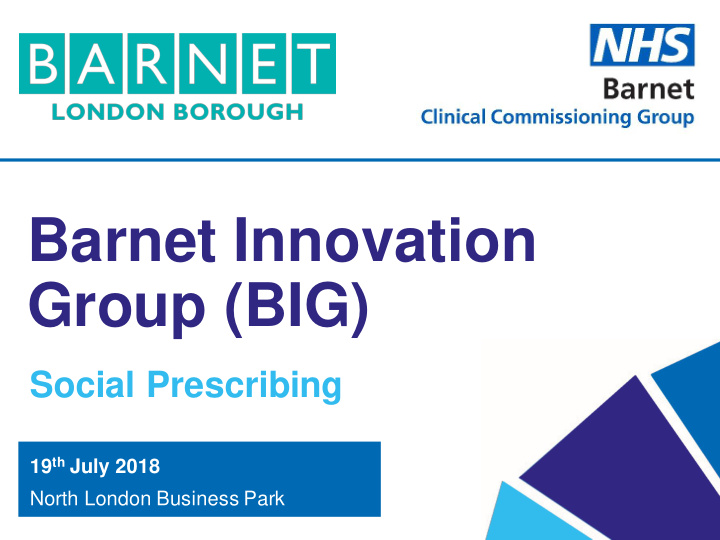



Barnet Innovation Group (BIG) Social Prescribing 19 th July 2018 North London Business Park
Welcome Ali Malik Director of QIPP, Planning and Performance – Barnet CCG 1
Overview of the session 1 An introduction to Social Prescribing Seher Kayikci 2 Barnet’s current SP models / interventions Jeff Lake / Seher Kayikci Table discussion – is this what we should be doing? 3 Engaging the whole system Ali Malik / Table discussion Dr Nicholas Mistry – how should we better engage the system? Establishing an integrated coordination 4 Dan Glasgow / process Conan Cowley Table discussion – ideas on what’s needed and how 5 Ali Malik Wash up and next steps
An introduction to Social Prescribing Seher Kayikci Senior Health Improvement Specialist – London Borough of Barnet 3
What is Social Prescribing? 4
Background • Marmot Review (2010) ‘Fair Society, Healthy Lives’ • The Five Year Forward View (NHS England, 2014) • Department of Health (2015) Policy paper: 2010 to 2015 government policy: long term health conditions • The King’s Fund (2016) Understanding pressures in general practice • The Care Act (2014) • Mayor of London (2017) ‘Better Health For All Londoners’ Draft Health Inequalities Strategy 5
Drivers Ten high impact actions to release capacity in general practice 6
Data from 5,128 consultations GPs judged 26% of their consultations to be potentially avoidable … 18% are about how the practice manages its workload 7
What is Social Prescribing? Social Prescribing Network defines social prescribing as: ‘A means of enabling GPs and other frontline healthcare professionals to refer patients to a link worker - to provide them with a face to face conversation during which they can learn about the possibilities and design their own personalised solutions , i.e. ‘co - produce’ their ‘social prescription’ - so that people with social, emotional or practical needs are empowered to find solutions which will improve their health and wellbeing , often using services provided by the voluntary, community and social enterprise sector’. • https://www.youtube.com/watch?v=O9azfXNcqD8 8
Impact Demand assessment % reduction Average 28% (2% – 70%) GP consultations A&E attendance Average 24% (8%-27%) Emergency hospital admissions 6% - 36% Outpatient referrals Up to 64% Mental health care Mixed results Rotherham CGG projects a ROI of £3.38 for every £1 spent after five years. https://www.westminster.ac.uk/file/107671/download • Aim: to build a Common Framework for Measuring the Impact of Social Prescribing 9
Our current SP models and initiatives Seher Kayikci / Jeff Lake London Borough of Barnet 10
Social Prescribing Models 1. Referral to a commissioned ‘one -stop connector service’ Referers Connectors Prescription GP , Integrated Care Community navigator or Community Groups -gardening, ‘link worker’, employed singing, dance, peer support – team, Library staff, self referral in the VCSE sector funded/non-funded 2. Community-Centred Practices: GP surgeries as community ‘hubs’, invite citizens in to work collaboratively, as ‘health champions’. 3. In-house ‘community link workers/ care navigators’ – employed by GP Practices. 4. Direct referral: GPs and other healthcare professionals refer patients directly to social prescribing services. 11
Social Prescribing Developments • Social prescribing is included in 75% of Sustainable Transformation Plans (STPs). • Healthy London Partnership Provide intensive support to the five STP areas in London, mapping current provision and defining plans to embed social prescribing by 2020. • Nearly half of all Clinical Commissioning Groups (CCGs) are investing in social prescribing ‘connector’ programmes. • 1in 5 GPs regularly refer patients to social prescribing. 40% would refer if they had more information about available services (July 2017, GP Online Survey). • Social prescribing secondary care pilot is underway 12
Social Prescribing Local Picture 1. Over 1,200 charities operating in Barnet (JSNA 2015) 2. A wide-range of Care Navigation, Link Working, Community Access, Coaching and Peer Support roles 3. Directory of Community Services (LBB) 4. Reimagining Mental Health - Barnet Wellbeing Hub and Link Workers (Barnet CCG) 5. Community Centred Practice – Practice Health Champions (Public Health) 6. Touchpoint (Lottery Fund - Inclusion Barnet) 7. Prevention and Wellbeing Co-ordinators (Adult Social Care) 13
Our current SP models and initiatives Table discussion 14
Engaging the whole system Dr Nicholas Mistry / Ali Malik Barnet CCG 15
Key players to engage Patient Groups GPs / Primary Voluntary Care Sector Individuals eligible for SP Community Adult Social Providers Care Acute Providers 16
Engaging the whole system Table discussion 17
Establishing an integrated coordination process Dan Glasgow / Conan Cowley Barnet CCG 18
Key discussion areas • How could you ensure there is sufficient capacity to signpost and support additional service users? • How could a model within Barnet be sustainable? • How can technology be used to join-up processes / services? • How could a model be implemented within Barnet? 19
Wash up and next steps Ali Malik Barnet CCG 20
Recommend
More recommend